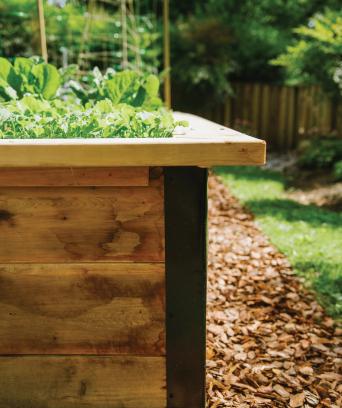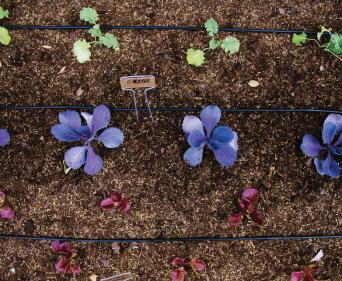
Take Steps Now to Cut Down on Weed Growth in the Spring
Managing weeds doesn’t have to be a Sisyphean time suck. To keep weeds from taking all the fun out of gardening, you’ll need to focus on three objectives:
- Keeping old weed seeds from germinating;
- Keeping out new weed seeds, and
- Preventing germinated weed seeds; from growing
At Backyard Eats, we work to achieve these outcomes in our clients’ gardens year after year.
Keeping Old Weed Seeds from Germinating
The majority of weed seeds in the garden lay dormant in the soil, waiting for light and air so they can germinate. It’s helpful to think of garden soil as having seeds dispersed throughout its volume. This is especially true for older gardens, or those that have experienced a lapse in maintenance.
We keep seeds dormant by avoiding turning the soil. When we remove tomato plants, for example, we cut the stem just below the soil, remove the vegetative portion, and leave the roots to decompose over time. By avoiding pulling the expansive root system from the soil, we avoid bringing old seeds to the surface.
We also avoid tilling, because that brings old weed seeds to the surface. This would be a problem in a traditional large rectangular garden, in which rows are walked on and compressed throughout the season. But by creating permanent walking paths, and beds no wider than four feet, we’re able to avoid the need to walk on and compress garden soil. By building up beds with wood, we are establishing a clear and permanent separation between growing areas and walking areas. This is one of many reasons that the raised bed is the tool of choice for Backyard Eats and many gardeners around the world.
Each year we add a layer of compost and mulch to the tops of our clients’ gardens; we call it winter bed care. Early December works best for us, but this should be done any time in the fall or early winter for a bed that is mostly weed-free and ready to plant with no additional effort come spring. We never till or mix the compost into the soil, unless we’re doing a remedial overhaul of “dead” soil.
Compost adds organic matter and life to the soil and improves drainage properties; it can also be used as mulch if no other mulch is available. While the science isn’t clear on how it works, compost has a weed suppressant effect when applied evenly over the surface like a mulch. Shredded leaves, salt hay, pine needles and any other organic matter with small particle sizes would also make good mulch for your annual beds.
Keeping New Weed Seeds Out of the Soil
When new weed seeds come from afar, they’re blown in from neighbors or dropped by birds. They’re mostly unavoidable but can be managed.
In contrast, seeds from domestic sources can cause a problem. A mature weed plant in the garden along the border or in the walking paths can drop hundreds or thousands of seeds. If I catch a weed flowering in my garden or yard but don’t have time to pull weeds or properly address the issue, I’ll dodge the impending doom by grabbing the flowers and yanking them off. No flowers, no seeds!
The other dangerous domestic source of seeds is homemade compost. If your compost doesn’t reach temperatures of over 120° for a few days, then it isn’t destroying seeds. Experience has told me that maintaining a true hot compost is a lofty goal for most homeowners; it’s better to avoid putting anything with seeds in the compost. This includes weeds cleared from other areas that have gone to seed, and seeds in kitchen compost like pumpkin, tomato etc.
Keeping Germinated Weed Seeds from Growing
Since there will always be some weed seeds that make it to the seedling stage, we have a few ways to keep them from ruining our day. Drip irrigation provides water directly to the soil where our desirable plants are growing, whereas a sprinkler incidentally waters the weeds growing in paths and borders (and causes serious plant health issues for most fruiting plants).
If your garden relies on irrigation from a sprinkler system, talk to your irrigationist about changing sprinkler head types to avoid the vegetable garden and hooking into the system with drip tubing.
Vinegar combined with a couple drops of soap is a top choice for killing weeds on your paths, especially in hot and dry conditions. The tops of weed plants can be knocked back easily and safely with a bit of spraying. Take care to avoid damaging your desirable plants with vinegar mist.
For weeds in the gardens, hand pulling is effective and satisfying, but for large gardens, you’ll want to get a collinear or stirrup hoe. These allow the use of a back-and-forth sweeping motion to cut off weeds at the connection to their roots, or just below soil level. I was delighted to find how useful a stirrup hoe was in our ornamental gardens, which I typically neglect in favor of our vegetable gardens.
A special kind of hoe called a wire head or wire weeder is useful for detailing. The wire can be pushed and pulled across the surface close to the stems of desirable plants to eliminate weeds without harming the crop.
At Backyard Eats our service offerings and team are shaped by the needs of home gardeners. If you’d like help with your garden, a fall or winter consult will give you the best shot at being prepared for spring. We apply compost and mulch in our Winter Bed Care service in early December.
Chris Mattingly is the founder of Backyard Eats, a full-service food gardening business with an array of offerings in the greater Philadelphia area. Email him at chris@backyard-eats.com or visit www.backyard-eats.com.

